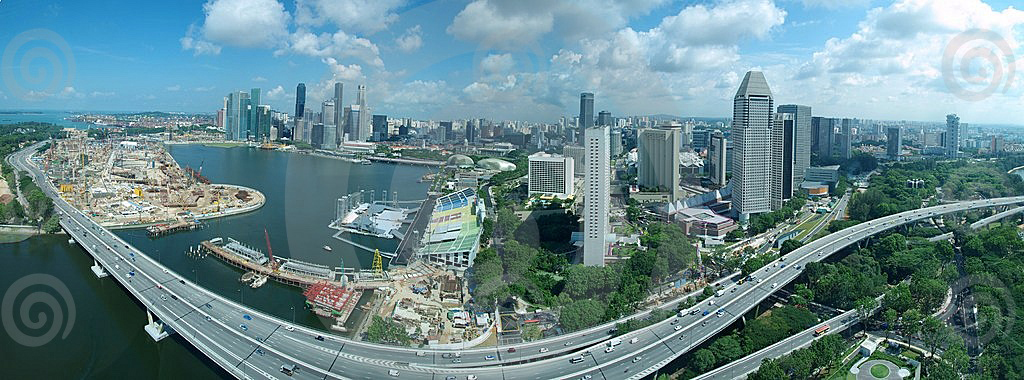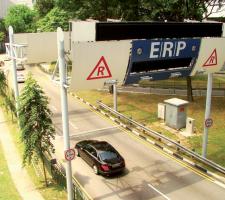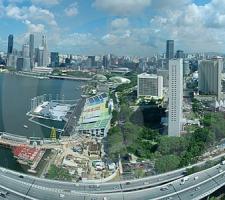
David Crawford investigates new detection analysis technology from IBM
Locations on both the East and West Coasts of the US are scheduled for early deployments ofTPT, which uses adaptive statistical techniques in conjunction with automated error correction for multiple time horizons, has already completed successful tests in Singapore. The island state's
The LTA wanted further to develop the i-Transport core of its ITS Centre. This integrates its Green Link computerised traffic signal array, TrafficScan real-time speed information service (which uses the island's 11 000-strong taxi fleet as probe vehicles), Expressway Monitoring Advisory System, Junction Electronic Eyes (which uses image-processing and artificial intelligence for real-time detection of congestion and incidents at key intersections) and Electronic Road Pricing (ERP) operation - the tools that provide the LTA with its operational and historical traffic data.
The trial showed that both speed and vehicle volume predictions covering the Central Business District over pre-set durations of 10, 15, 30, 45 and 60 minutes.surpassed the target accuracy of 85 per cent. In peak periods, when more real-time data was available, the average accuracy of the volume forecasts was near or above 90 per cent.
As a result, IBM is confident that it has overcome the doubts of researchers who have historically expressed doubts about the possibility of accurately predicting road traffic conditions, arguing instead in favour of 'chaotic behaviour'. "We have found that the actual data suggests otherwise," says the company.
| Component | Function |
| DEA Real-time component | Operates on the most recent traffic snapshot to render it consistent with observed traffic flows and speeds, where available, through the use of offline-computed splitting probabilities. |
| Offline component | DEA learns changes in traffic behaviour and updates the snapshot on a weekly basis. It computes splitting probabilities to be used in a fast real-time procedure. |
| DEA Speed | Uses splitting probabilities and observed speeds. Future releases may include an offline component for speed. |
Further progress in Singapore will benefit from IBM's September 2009 complementing of the TPT with a new Data Expansion Algorithm (DEA). This is designed to fill in missing traffic volume and speed data on sections of the road network and so achieve greater levels of detection accuracy.
Particularly relevant in urban contexts, DEA-type estimates are critical for enabling the correct functioning of end-to-end analytics for applications including accurate travel-time displays and route guidance information. They make use of historical and average-case data to build a snapshot of typical traffic flows across the network.
IBM has tested the DEA on a number of networks, including two in Germany (the one in Berlin being comparable to Singapore's). The combination of TPT and DEA - now effectively a single package - is a key component in the LTA's next-stage Bus Arrival Project, which envisages an initial deployment at 25 stops in the Singapore CBD.
A current (non-public) test phase is due to be followed by trials with the travelling public in early 2011. The system will be based on GPS readings from buses linked to TPT-DEA traffic predictions.
Charging applications
One of the aims of the TPT trial was to explore the feasibility of highly variable pricing within Singapore's ERP system. This would be based on accurate estimates of prevailing and emerging traffic conditions, with drivers being alerted about traffic conditions ahead and the prices applicable at that moment."Predicting traffic helps you predict pricing," says Laura Wynter, an IBM researcher who has worked with the Authority. Algorithms developed by IBM could drive a flexible system that the LTA's public policymakers hope could be more effective in changing travel behaviour than previous attempts to reduce traffic.
The trial results will therefore be a key input into a new System Evaluation Test (SET), for which the LTA announced in June 2010 that it was calling for tenders from qualified companies. The SET will trial technological solutions for a next-generation ERP2 scheme, at present in its conceptual stage.
The LTA foresees the end of the current ERP system - a world-first example of automated urban congestion charging when installed in 1998 - which uses gantries carrying Dedicated Short-Range Communication (DSRC) sensors for automatic charging of transponder-equipped vehicles and cameras for identification. The authority has recognised that the present procedure of continually adding new gantries to cope with increasing demands for road space is not viable in the long term.
Based on the results of past technology studies and a preliminary evaluation of the available alternatives, it has therefore identified a number of potential options based on GNSS technology. The problem is that while this has proven to be highly appropriate for the open autobahns of Germany, Singapore's dense urban environment presents a far greater challenge (not least in needing to allow for the charging of different vehicle types at appropriate rates).
Europe
In Finland, where IBM has also tested the TPT, the Finnish Transport Agency (which runs the national road network) has recently announced a new project with the company. It is using another data analysis product, Cognos 8, to create an aggregated overview of road conditions, accident and traffic information and so improve overall highway management. Statistics-led
Singapore-based IBM TPT researcher Wanli Min looks forward to cities having the capability to predict both incoming traffic congestion and the amount of time that it will take to clear currently congested areas. As a result they will be better able, for example, to deliver navigation guidance based on future rather than current traffic conditions.
The TPT project, he says, has reinforced his view of statistics as a worthwhile tool for analysing traffic conditions. In a statistical mechanics class, he studied the Maxwell speed distribution, which describes the probability density function of moving speeds of molecules in the air.
This showed how the macroscopic observerables that originate from the collective behaviour of a microscopic system with a large number of participants can be characterised by relatively simple maths formulae. Over time, his interest in statistics grew and eventually led him into his current field.
The Maxwell formulae can substitute individual vehicles for molecules for the purposes of traffic prediction. Another spur was Akaike's Information Criterion (AIC), developed by Japanese statistician Hirotsugu Akaike as a measure of the goodness of fit in selecting from a range of pssible statistical models.
Wanli Min sees it as key to the success of TPT, as it can be used to select models against parameters critical for avoiding the risk of instability or a drop in accuracy."Working with IBM, we are able to combine information from previously isolated silos and road users will benefit from safer and smoother traffic flows," comments FTA project manager Kristiina Laakso. Expected benefits include early detection of potentially dangerous road sections, with the resulting data being used to prioritise maintenance.
The analytics solution is also compatible with maps from the
The pioneering LTA-IBM pilot, funded from Singapore's US$10 million Land Transport Innovation Fund set up to accelerate innovation, was supported by a global IBM team, drawing on
resources from Singapore, the UK and the US. It represents a key element in IBM's Global Innovation Outlook (GIO) Urban Transportation Project.
The company set this up to open up IBM's business and technology forecasting processes as a platform for discussing business, societal and technological issues with global thinkers and partners. The follow-on GIO 2.0 identified transportation and mobility as a focus area for potential innovation, notably in preventing or mitigating traffic congestion in conurbations.
It subsequently set up the Urban Transport Project to develop potential solutions. IBM has since been working with cities around the globe to set up additional pilots.













